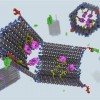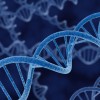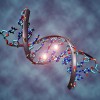Posts tagged Cancer

Jumping Down the Road to Cancer.
Aug 28th
Lying dormant in our genomes are millions of jumping genes. Originally discovered by Barbara McClintock, transposons are DNA sequences that can move from one location to another in our DNA. Transposons cause mutations when they jump to new locations, so keeping them from jumping is important. However, although transposons are largely silent, every person probably has a few “rare” sites, found in only a few people in the world, where a transposon has jumped to a new location.
Mutations in numerous pathways need to accumulate for cancer to progress. Given the ability of transposons to cause mutation and the role of mutation in More >

Future Nobel Prize-winning cancer researchers?
Mar 19th
What did you do for your science fair this year? Or last year? Or 20 years ago?
Recently three high school students took out top honors in science fairs for their projects involving cancer research:
- Angela Zhang from California developed nanotechnology to destroy cancer stem cells and win the 2011 Siemens Competition in Math, Science & Technology;
- Shree Bose from Texas discovered a protein that could help prevent resistance to chemotherapy to take out first prize in the first International Google Science Fair; and
- Michigan native Nithin Tumma won the 2012 Intel Science Talent Search with his investigation of molecular pathways to compare breast cancer More >

Exhausting Our Lungs
Mar 7th
I have often wondered what impact the diesel fumes from yellow school buses might have on students. I know that I don’t like driving behind those buses because the fumes don’t smell good, so it seemed to me that there might be some health consequences. Others have wondered, too, and there is evidence that exhaust levels in buses can have health effects. However, it is hard to study this sort of thing, because finding people that are exposed to high levels of diesel in a controlled environment over long enough periods to measure the effects is challenging. Now, a study More >

What do you get when you cross an immunologist, a nanotechnologist, and a geneticist? A DNA nano-robot!
Feb 17th
Welcome to the world of nanobiotechnology and translational research…
In a brilliant example of multidisciplinary research, Harvard Medical School’s Shawn Douglas, Ido Bachelet, and George Church combined forces to build nanostructures that would mimic the body’s immune system to recognize cancer cells and trick them into self-destructing. Their research is published today in Science but the discovery didn’t just happen overnight. It’s the culmination of several key discoveries going back several years, by researchers around the globe.
In 2006, Paul Rothemund at the California Institute of Technology, discovered “DNA origami,” where the Watson-Crick base-pairing rules are exploited to create molecules from viral DNA More >

Controlling gene expression through diet
Feb 16th
Epigenetics is the study of chemical reactions that control the on and off switch of genes at specific times and the factors influencing them. Environment is a factor that influences epigenetic change which may encompass behavior, stress or diet. The easiest of the three to make observations from is diet. When we think of food, rarely do we think of chemical modifications to DNA and restriction of gene activity. Commonly we think of foods coming in and being broken down into nutrients to be utilized in metabolic pathways to make components the body can use. Interestingly one of the pathways More >

Tumor Treatment: Whether to Shrink or Not to Shrink
Feb 6th
Just like normal tissue, tumors need blood vessels to grow. Because of this, drugs that stop angiogenesis, or the formation of new blood vessels, are one important approach to treating cancers. These angiogenesis inhibitors stop tumor growth by starving them of oxygen and nutrients, usually by interfering with signals from the tumor cells that promote blood vessel formation in the surrounding tissue. Angiogenesis inhibitors have been shown to be effective in the treatment of several cancer types, but the results aren’t always as expected. Several recent studies show how complicated this can be. For instance, FDA approval of the drug More >

Tag…You’re It!
Jan 19th
Classic genetics alone is unable to explain the diversity we see within a population of living things. This also cannot explain how identical twins with the same DNA sequences can have differences in their traits and development of disease. First introduced in 1939 by C.H. Waddington, epigenetics is now able to offer some explanation, as it studies the heritable changes in gene expression that are not due to any alteration in the DNA sequence.
This may help to answer many questions. How can we have so many different types of cells and they all carry the same genetic information? How is More >

Mapping the migratory patterns of……brain cancer cells?
Jan 18th
We’ve all watched fascinating David Attenborough documentaries about the migratory patterns of birds, sub-Saharan animals and butterflies, but cancer cells? Yes, cancer cells migrate too. More specifically, brain cancer cells.
Researchers have known for a while that not only are glioblastoma multiforme cells highly resistant to chemotherapy, but they can also deftly migrate away from sites of radiation or surgery, setting up camp and regrowing in other parts of the brain. This means that brain cancer is notoriously difficult to treat and the prognosis is almost always grim.
Last year the New York Times described Hanahan and Weinberg’s Hallmarks of Cancer as follows:
“Through a More >

Trying to unlock a new door…..
Nov 28th
How is drug development moving along? Well, this is a very good question for we are still plagued by some elusive diseases, cancer for example. There have been many drugs developed targeting proteins involved in disease states some of which have proven to be quite effective. However today the steam engine for identifying drug targets to proteins involved in disease is becoming ever more difficult. Apparently over the past decade or so, the number of new drugs targeted toward disease has declined. This is primarily due to the fact that developing new medicine has become more difficult to do. It More >

